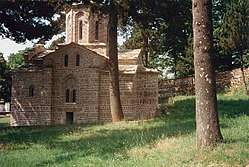Jovan Dragoslav
Dragoslav (Serbian Cyrillic: Драгослав) or Jovan Dragoslav (Јован Драгослав; fl. 1290–1315) was a Serbian nobleman with the titles of kaznac, and then veliki kaznac, serving King Stefan Milutin (r. 1282–1321). The kaznac was a financial-taxation office, translated into Latin camerarius (chamberlain).[2] In the hierarchy of the Serbian court, kaznac ranked higher than stavilac and čelnik, and lower than tepčija and vojvoda, the supreme title.[3] He was part of the generation of Serbian nobility that were empowered in the early 14th century.[4]
Jovan Dragoslav | |
|---|---|
| veliki kaznac | |
 The church he founded in Mušutište. It was destroyed in 1999. | |
| Titles and styles | |
| Born | Kingdom of Serbia |
| Died | after 1315 |
| Spouse | Jelena[1] |
| Issue
Staniša (son) and Ana (daughter)[1] | |
| Religion | Eastern Orthodoxy |
Dragoslav served as kaznac in the area of Skopje, mentioned in ca. 1300, then was elevated to veliki kaznac some time prior to 1315.[5] According to P. Grujić, he first served Milutin in ca. 1290 as sluga, became kaznac in ca. 1300, then veliki kaznac in ca. 1315.[6] P. Grujić stressed that his career started as sluga (a special court office, similar to stavilac[7]), mentioned in a confirmation of Ragusan privileges.[8] Ferjančić was unsure of this,[8] while the Serbian Institute of Byzantinology now agrees that Dragoslav began his rise on Milutin's court as sluga.[9] In 1300, he was mentioned along his wife kyra Jelena, and at that time held the region of Sušica which was around Žegligovo.[10] He donated a vineyard, called Mavrovo, to the Monastery of St. George near Skopje,[8] as part of Milutin's endowments.[11] He founded the Church of the Virgin Hodegetria in the village of Mušutište, near Prizren, together with his wife, son and daughter in 1315.[1] Dragoslav had acquired good master artists for his church.[12] In an inscription in the church, his elevated title of veliki kaznac is mentioned — this meant that he was the supreme court administrator of state assets.[13] According to Svetislav Mandić, he later had the title of despot.[14] It was possibly given to him by Byzantine Emperor Andronikos II Palaiologos (r. 1272–1328).[15] Mandić also believes that he received the name Jovan from the church (as did Jovan Oliver),[16] of a special honorable character, and was not born with it.[6] According to some, Dragoslav married Teodora, the mother of Stefan Dušan and former Queen consort, sometime between 1322 and 1326, and thence received the title of despot.[17]
His church was destroyed with explosives in 1999 by ethnic Albanians.[18]
See also
- Dragoš (fl. 1290s), veliki župan of Stefan Milutin
- Novak Grebostrek (fl. 1312–14), veliki vojvoda of Stefan Milutin
References
- Srejović, Gavrilović & Ćirković 1982, p. 494.
- Purković 1985, p. 27.
- Blagojević 2001, p. 211.
- Miloš Blagojević; Sreten Petković (1989). Srbija u doba Nemanjića: od kneževine do carstva : 1168-1371 : ilustrovana hronika. TRZ VAJAT. p. 202.
- Blagojević 2001, p. 21.
- Mandić 1981, p. 71.
- Blagojević 2001, p. 301.
- Ferjančić 1960, p. 157.
- Vizantološki institut (2004). Zbornik radova. 41–42. Srpska akademija nauka i umetnosti. p. 267.
- Srpska akademija nauka i umetnosti 1908, p. 203.
- Naučno društvo Bosne i Hercegovine. Odjeljenje istorijsko-filoloških nauka (1963). Posebna izdanja. 1. Naučno društvo SR Bosne i Hercegovine. p. 71.
- Branislav Todić (1998). Srpsko slikarstvo u doba Kralja Milutina. Draganić.
- Borislav Pelević; Artemije Radosavljević (2007). Raspeto Kosovo i Metohija: sveta srpska zemlja. Evro-Giunti. p. 157.
- Mandić 1986, p. 192.
- Mandić 1990, p. 219.
- Mandić 1986, p. 106.
- Ferjančić 1960, pp. 157–158.
- "Mušutište: Služena prva liturgija nakon 12 godina". Kurir. 12 June 2011.
Sources
- Blagojević, Miloš (2001). Državna uprava u srpskim srednjovekovnim zemljama. Službeni list SRJ. pp. 21–23.CS1 maint: ref=harv (link)
- Ferjančić, Božidar (1960). Despoti u Vizantiji i Južnoslovenskim zemljama. Naučno Delo.CS1 maint: ref=harv (link)
- Mandić, Svetislav (1986). Velika gospoda sve srpske zemlje i drugi prosopografski prilozi. Srpska književna zadruga. pp. 53, 106, 192.CS1 maint: ref=harv (link)
- Mandić, Svetislav (1990). "Деспот Јован Драгослав". Carski čin Stefana Nemanje: činjenice i pretpostavke o srpskom srednjovekovlju. Srpska književna zadruga. pp. 216–220.CS1 maint: ref=harv (link)
- Mandić, Svetislav (1981). Črte i reze: fragmenti starog imenika. Slovo ljubve. pp. 71–75.CS1 maint: ref=harv (link)
- Purković, Miodrag (1985). Srpska kultura srednjega veka. Izd. Srpske pravoslavne eparhije za zapadnu Evropu. p. 27.CS1 maint: ref=harv (link)
- Srejović, Dragoslav; Gavrilović, Slavko; Ćirković, Sima M. (1982). Istorija srpskog naroda: Od najstarijih vremena do Maričke bitke (1371). Srpska književna zadruga. p. 494.CS1 maint: ref=harv (link)
- Srpska akademija nauka i umetnosti (1908). Glas. 78–80. Srpska akademija nauka i umetnosti. p. 203.CS1 maint: ref=harv (link)
| Court offices | ||
|---|---|---|
| First | veliki kaznac of King Stefan Milutin fl. 1315 |
Succeeded by ? |
| Preceded by Mrnjan as serving Stefan Uroš I |
kaznac of King Stefan Milutin fl. 1300 Served alongside: Miroslav (fl. 1306) |
Succeeded by Baldovin as serving Stefan Dečanski |